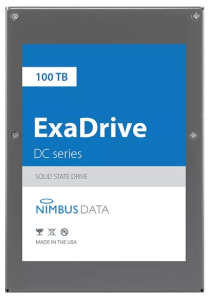 Nimbus Data, a pioneer in flash memory solutions, today announced the ExaDrive DC100, the largest capacity (100 terabytes) solid state drive (SSD) ever produced. Featuring more than 3x the capacity of the closest competitor, the ExaDrive DC100 also draws 85% less power per terabyte (TB). These innovations reduce total cost of ownership per terabyte by 42% compared to competing enterprise SSDs, helping accelerate flash memory adoption in both cloud infrastructure and edge computing.
Nimbus Data, a pioneer in flash memory solutions, today announced the ExaDrive DC100, the largest capacity (100 terabytes) solid state drive (SSD) ever produced. Featuring more than 3x the capacity of the closest competitor, the ExaDrive DC100 also draws 85% less power per terabyte (TB). These innovations reduce total cost of ownership per terabyte by 42% compared to competing enterprise SSDs, helping accelerate flash memory adoption in both cloud infrastructure and edge computing.
“As flash memory prices decline, capacity, energy efficiency, and density will become the critical drivers of cost reduction and competitive advantage,” stated Thomas Isakovich, CEO and founder of Nimbus Data. “The ExaDrive DC100 meets these challenges for both data center and edge applications, offering unmatched capacity in an ultra-low power design.”
Optimized to Maximize Flash Storage Capacity and Efficiency
While existing SSDs focus on speed, the DC100 is optimized for capacity and efficiency. With its patent-pending multiprocessor architecture, the DC100 supports much greater capacity than monolithic flash controllers. Using 3D NAND, the DC100 provides enough flash capacity to store 20 million songs, 20,000 HD movies, or 2,000 iPhones worth of data in a device small enough to fit in your back pocket. For data centers, a single rack of DC100 SSDs can achieve over 100 petabytes of raw capacity. Data centers can reduce power, cooling, and rack space costs by 85% per terabyte, enabling more workloads to move to flash at the lowest possible total cost of ownership.
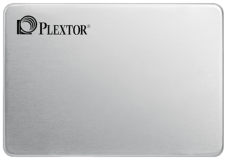 CDRLabs has taken an in depth look at Plextor's latest SATA SSD, the M8V. This entry-level device is powered by Silicon Motion's SM2258 controller and is available with up to 512GB of Toshiba's 64-layer BiCS3 3D TLC NAND flash. To compensate for the slow write speeds typically associated with TLC NAND, the M8V is equipped with Plextor's PlexNitro cache acceleration technology, which optimizes performance without taking up any space on the drive. The M8V also features built in LDPC technology as well as a RAID engine and data shaping for enhanced data transfer stability. To top it all off, the drive supports Plextor exclusive applications like PlexTurbo, PlexCompressor and PlexVault.
CDRLabs has taken an in depth look at Plextor's latest SATA SSD, the M8V. This entry-level device is powered by Silicon Motion's SM2258 controller and is available with up to 512GB of Toshiba's 64-layer BiCS3 3D TLC NAND flash. To compensate for the slow write speeds typically associated with TLC NAND, the M8V is equipped with Plextor's PlexNitro cache acceleration technology, which optimizes performance without taking up any space on the drive. The M8V also features built in LDPC technology as well as a RAID engine and data shaping for enhanced data transfer stability. To top it all off, the drive supports Plextor exclusive applications like PlexTurbo, PlexCompressor and PlexVault.

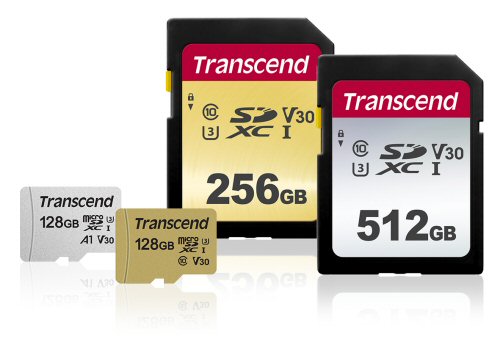
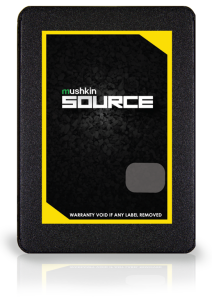 Mushkin Enhanced MFG, an industry-leading designer and manufacturer of high-performance computer products, is announcing the
Mushkin Enhanced MFG, an industry-leading designer and manufacturer of high-performance computer products, is announcing the 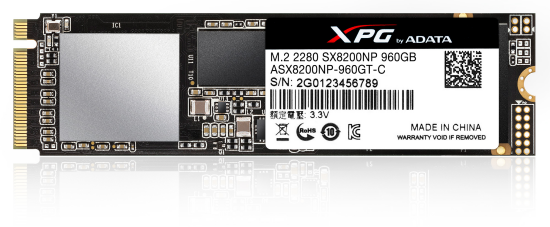
 LITE-ON Storage, an established leader in the rapidly expanding solid-state drive (SSD) industry, said today it will demonstrate its latest enterprise drives, the NVRAM Hybrid SSD, during the OCP U.S. Summit 2018, kicking off here today.
LITE-ON Storage, an established leader in the rapidly expanding solid-state drive (SSD) industry, said today it will demonstrate its latest enterprise drives, the NVRAM Hybrid SSD, during the OCP U.S. Summit 2018, kicking off here today. Samsung Electronics Co., Ltd., the world leader in advanced memory technology, today announced that it is rolling out its PM883, the highest density datacenter SATA drive, at eight terabytes (TB). Samsung’s new solid state drive (SSD) offering is the industry’s first datacenter SATA drive to incorporate LPDDR4 DRAM modules and features a 6.0-gigabits-per-second (Gbps) 2.5-inch SATA interface.
Samsung Electronics Co., Ltd., the world leader in advanced memory technology, today announced that it is rolling out its PM883, the highest density datacenter SATA drive, at eight terabytes (TB). Samsung’s new solid state drive (SSD) offering is the industry’s first datacenter SATA drive to incorporate LPDDR4 DRAM modules and features a 6.0-gigabits-per-second (Gbps) 2.5-inch SATA interface.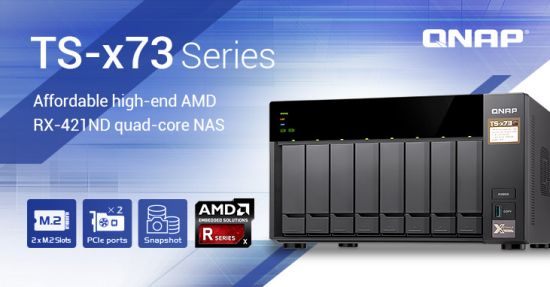
 Nimbus Data, a pioneer in flash memory solutions, today announced the ExaDrive DC100, the largest capacity (100 terabytes) solid state drive (SSD) ever produced. Featuring more than 3x the capacity of the closest competitor, the ExaDrive DC100 also draws 85% less power per terabyte (TB). These innovations reduce total cost of ownership per terabyte by 42% compared to competing enterprise SSDs, helping accelerate flash memory adoption in both cloud infrastructure and edge computing.
Nimbus Data, a pioneer in flash memory solutions, today announced the ExaDrive DC100, the largest capacity (100 terabytes) solid state drive (SSD) ever produced. Featuring more than 3x the capacity of the closest competitor, the ExaDrive DC100 also draws 85% less power per terabyte (TB). These innovations reduce total cost of ownership per terabyte by 42% compared to competing enterprise SSDs, helping accelerate flash memory adoption in both cloud infrastructure and edge computing.